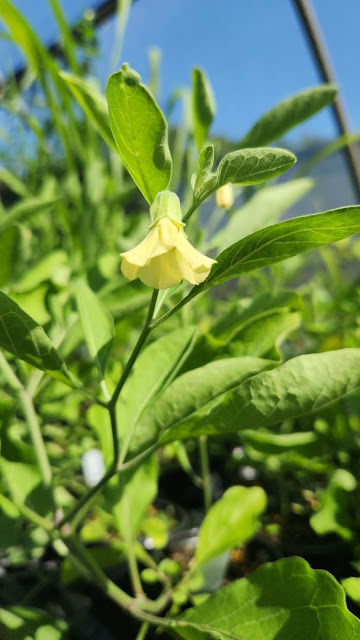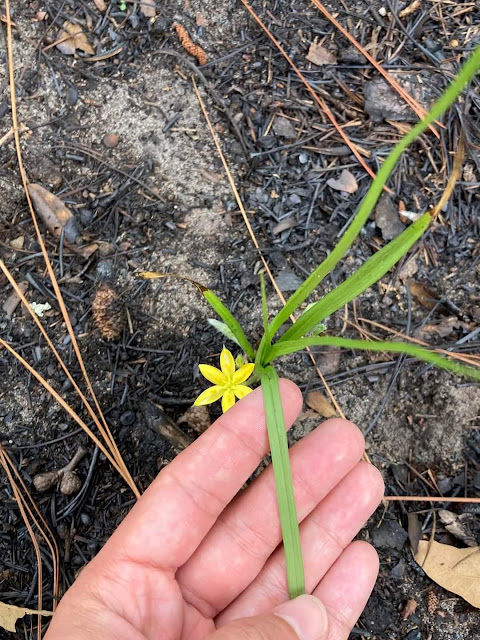For a good many years, I have been growing wildflowers at my home as a licensed nursery known as Hawthorn Hill. My goal has never been to make money but to make a greater diversity of weildflowers available to the public. I believe that I have achieved this goal with the growth in the number of native nurseries and with my ability to grow my plants and sell them at my place of work - The USF Botanical Gardens in Tampa. With our Plant Shop open from Tuesdays - Sundays and a larger propagation area to work with, I can grow more plants than ever and make it easier for everyone to access them.My last Open House is scheduled for Saturday, April 27, 9 am-noon and we will be selling everything we can before moving the plants we don't sell to the Botanical Gardens. We have ther largest diversity of species we've ever had. Below is the list. Some are currently in very short supply.
Most everything is in 4" pots, well rooted, for $5 each. The rare woody mints and a few others are $10. We prefer cash, but can take Visa & Mastercard as well as personal checks.
Jane and I hope to see you a week from Saturday - or later at the USF Plant Shop.
Natives in the Plant Shop/Hawthorn Hill Spring Open House
● *USF Plant Shop only
● #Not ready at this time
● @Very limited numbers
Abutilon hulseanum
Aesculus pavia*
Amorpha crenulata@
Amorpha fruticosa
Andropogon glomeratus
Andropogon spp. (unknown)
Andropogon ternarius
Annona glabra
Apios americana
Arnoglossum atriplicifolium
Arnoglossum ovatum var. lanceolatum
Argemone mexicana (later)
Asclepias incarnata
Asclepias perennis
Asclepias tuberosa
Asimina obovata@
Asimina pygmaea@
Asimina reticulata@
Baptisia alba
Brickellia mossieri
Calamintha coccinea@
Calamintha georgianum@
Callicarpa americana*
Chaptalia albicans#
Chaptalia tomentosa#
Carphephorus corymbosus#
Cicuta maculata
Clematis reticulata
Conradina canescens@
Conradina glabra@
Conradina spp.@
Dalea pinnata
Diospyros virginiana*
Echinacea purpurea
Encyclia tampensis
Eriogonum tomentosum
Eryngium yuccifolium
Erythrina herbacea@
Flaveria linearis
Garberia heterophylla*
Hamelia patens*
Hibiscus grandiflorus
Hibiscus laevis
Hibiscus moscheutos
Hibiscus poeppigii
Ipomoea imperati*@
Ipomopsis rubra
Lespedeza capitata#
Lespedeza hirta#
Lespedeza virginica#
Liatris chapmanii
Liatris elegans
Liatris laevigata
Liatris savannensis
Lonicera sempervirens*
Nemastylis floridana
Nyssa ogeche*
Palafoxia feayi#
Pediomelum canescens
Penstemon laevigata
Penstemon multiflorus
Physalis walteri
Picramnia pentandra*
Piptochaetium avenaceum#
Psychotria tenuifolia
Randia aculeata*
Rhyncosia minima
Rudbeckia hirta
Rudbeckia laciniata
Rudbeckia triloba
Saccharum giganteum
Salvia coccinea
Salvia lyrata
Saururus cernuus*
Senna ligustrina
Sericocarpus tortifolius#
Solidago odora var. chapmanii
Solidago petiolaris#
Sorghastrum apalachicolense
Sorghastrum nutans@
Stokesia laevis@
Symphyotrichum bahamense
Symphyotrichum carolinianum
Symphyotrichum concolor
Symphyotrichum dumosum
Symphyotrichum elliottii
Symphyotrichum georgianum
Symphyotrichum laeve
Symphyotrichum lanceolatum
Symphyotrichum lateriflorum
Symphyotrichum patens#@
Symphyotrichum pilosum
Symphyotrichum plumosum
Symphyotrichum praealtum
Symphyotrichum sericeum
Symphyotrichum shortii
Symphyotrichum undulatum
Symphyotrichum walteri#
Trifolium reflexum
Ulmus americana*
Vachellia farnesiana*
Vernonia gigantea
Vernonia missurica
Vernonia novaboracensis
Zamia integrifolia*
Zanthoxylum clava-herculis


























